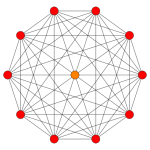Decagon
| Regular decagon | |
|---|---|
|
A regular decagon | |
| Type | Regular polygon |
| Edges and vertices | 10 |
| Schläfli symbol |
{10} t{5} |
| Coxeter diagram |
|
| Symmetry group | Dihedral (D10), order 2×10 |
| Internal angle (degrees) | 144° |
| Dual polygon | self |
| Properties | convex, cyclic, equilateral, isogonal, isotoxal |
In geometry, a decagon is any polygon with ten sides and ten angles.[1]
A regular decagon has all sides of equal length and each internal angle equal to 144°.[1] Its Schläfli symbol is {10} [2] and can also be constructed as a quasiregular truncated pentagon, t{5}, which alternates two types of edges.
Regular decagon
The area of a regular decagon is: (with t = edge length)[3]
An alternative formula is  where d is the distance between parallel sides, or the height when the decagon stands on one side as base, or the diameter of the decagon's inscribed circle.
By simple trigonometry,
where d is the distance between parallel sides, or the height when the decagon stands on one side as base, or the diameter of the decagon's inscribed circle.
By simple trigonometry,
and it can be written algebraically as
Sides
The side of a regular decagon inscribed in a unit circle is  , where ϕ is the golden ratio,
, where ϕ is the golden ratio,  .[4]
.[4]
Construction
A regular decagon is constructible using compass and straightedge. See File:Regular Decagon Inscribed in a Circle.gif. [4]
An alternative (but similar) method is as follows:
- Construct a pentagon in a circle by one of the methods shown in constructing a pentagon.
- Extend a line from each vertex of the pentagon through the center of the circle to the opposite side of that same circle. Where each line cuts the circle is a vertex of the decagon.
- The five corners of the pentagon constitute alternate corners of the decagon. Join these points to the adjacent new points to form the decagon.
Petrie polygons
The regular decagon is the Petrie polygon for many higher-dimensional polytopes, shown in these skew orthogonal projections in various Coxeter planes:[5] The number of sides in the Petrie polygon is equal to the Coxeter number, h, for each symmetry family.
| H3 | ||||
|---|---|---|---|---|
 Dodecahedron |
 Icosahedron |
 Icosidodecahedron |
 Rhombic triacontahedron |
|
| A9 | D6 | B5 | ||
 9-simplex |
 411 |
 131 |
 5-orthoplex |
 5-cube |
See also
- Decagonal number and centered decagonal number, figurate numbers modeled on the decagon
- Decagram, a star polygon with the same vertex positions as the regular decagon
References
- ↑ 1.0 1.1 Sidebotham, Thomas H. (2003), The A to Z of Mathematics: A Basic Guide, John Wiley & Sons, p. 146, ISBN 9780471461630.
- ↑ Wenninger, Magnus J. (1974), Polyhedron Models, Cambridge University Press, p. 9, ISBN 9780521098595.
- ↑ The elements of plane and spherical trigonometry, Society for Promoting Christian Knowledge, 1850, p. 59. Note that this source uses a as the edge length and gives the argument of the cotangent as an angle in degrees rather than in radians.
- ↑ 4.0 4.1 Ludlow, Henry H. (1904), Geometric Construction of the Regular Decagon and Pentagon Inscribed in a Circle, The Open Court Publishing Co..
- ↑ Coxeter, Regular polytopes, 12.4 Petrie polygon, pp. 223-226.
External links
- Weisstein, Eric W., "Decagon", MathWorld.
- Definition and properties of a decagon With interactive animation
| ||||||||||||||||||||||||||



